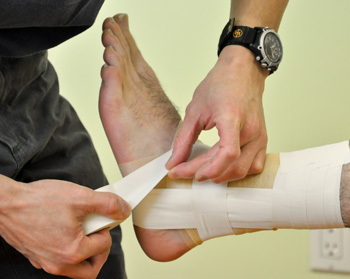
Taping vs. Bracing
For most athletes, taping and bracing are a way of life. They have certain injuries that, with taping or bracing, allow them to function like their non-injured teammates. No matter what the injury, when the athlete is finished with rehabilitation and recovery, they may need a little assistance to return to their previous level of competition. Taping and bracing greatly reduce the risk of re-injury. The question is which is best. For a short time, the athlete may need both. Eventually, they can use one or the other depending on the injured area.
TAPING
Taping gives a custom fit to the athlete’s body and may use different varieties of strengths depending on the severity of injury. However, that “custom support” may have some key flaws. First, the taping should only be done by a professional—an athletic trainer is the best choice. Most coaches or parents may have been taped or seen it done many times, but do not actually know why the different strips are used, which way they are applied or in which order. All of these factors can affect the quality of the taping process. Second, tape stays tight on the athlete for only a short time. Eventually, with sweat and activity, the binding forces of the tape will break down, and the support will be reduced. In a normal sports practice, the benefit of taping will only last a short time—about 15 minutes to a half hour. And finally, taping an unstable joint without proper rehabilitation may not allow the athlete to strengthen his or her body to full potential. The athlete should strengthen the surrounding muscles as a first line of defense against injuries.
BRACING
Bracing has similar flaws. First, an elastic brace (generally one you can pick up at a pharmacy or grocery store) will not give a joint much support in movement required by sports. It provides compression and keeps the joint warm, but will generally not prevent even the most minor injury. If a brace is necessary, ask a professional which brand or brands he or she recommends. Most will give you a general idea what to look for and at a price range you can afford. Second, bracing a joint without the presence of a real injury will not allow the body to strengthen to its full potential. A painful knee does not require a brace if no significant injury is present.
However, certain injuries to the knee may be resolved with rehabilitation and a proper brace, depending on the level of activity. Finally, an improperly used or improperly fitted brace may do more damage than good. Ask an athletic trainer or doctor which brace is best for that injury and instructions on how to use it for your sport. If a serious injury is present, most will know of a brace that can be custom fit to the athlete’s body.
In addition to the benefits of bracing listed above, a brace does allow an athlete to continue to tighten the fit as they participate. This may provide longer support than taping.
Depending on the joint or area of the body injured, taping may be the best solution. In general, smaller, bony body parts—such as thumbs, fingers, and wrists—may be better supported by tape. The athletic trainer can adjust the tension and angle of the tape to fit around these parts without compromising support. Most braces made for these areas are not the best choice for sports activity. They do not have to support a lot of body weight—like knees and ankles would. Additionally, there are certain joints and body parts that would not benefit from taping or bracing. Both work better on specific joints, rather than large areas of the body. The more focused the injury, the better the chance to prevent against its recurrence by taping or bracing. Always check with your athletic trainer or doctor before buying a brace. Your athletic trainer will know best about how to tape and if taping will be beneficial to you as you resume sports.
Leave a reply






<a href="https://trending-hashtag.com/hashtag-sports/">Sports Hashtag</a>
ReplyThanks for pointing out that taping could be custom-fitted to the athlete’s body and may be used differently depending on their injury. I hope that I can find a plastic-free sports tape for my husband now that he has an injury to his left foot. It’s after he tripped while he was jogging this morning due to the slippery road after it rained.
ReplyThanks for sharing this amazing piece of content with us,
ReplyI like that you talked about how taping will be custom-made for then athletes to help them with their injuries. I can imagine how sports medicine care is vital for the recovery of people who are physically active and competitive at the same time. Without these professionals, I wonder if the athletes who got injured would still be able to get back to their game and compete again.
ReplyEphuroalabs' joint support supplement offers a remarkable blend of ingredients, providing effective relief from joint discomfort and promoting mobility. Highly recommend for anyone seeking healthier, pain-free movement.
Reply